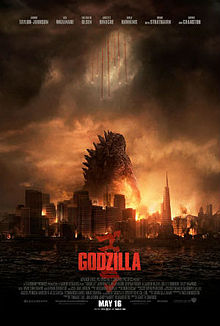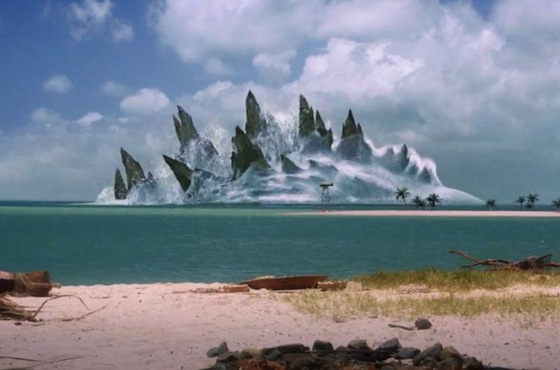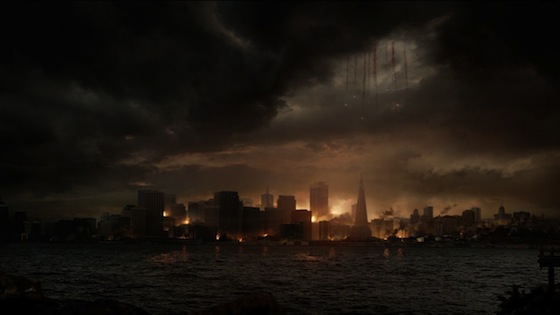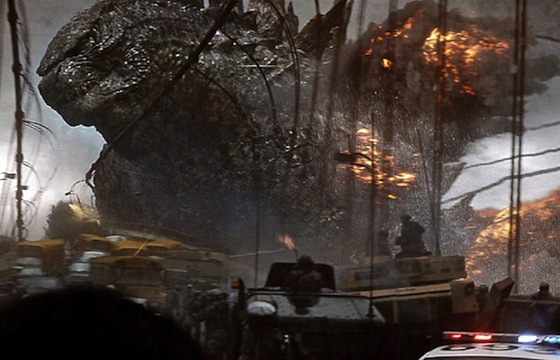 This Godzilla movie review originally appears at Lawrence.com. TV review from KCTV5’s It’s Your Morning.
This Godzilla movie review originally appears at Lawrence.com. TV review from KCTV5’s It’s Your Morning.
What kind of a movie would waste the talents of Oscar nominees Sally Hawkins, David Strathairn, Ken Watanabe and Juliette Binoche?
A Godzilla movie, that’s what kind.
Another way to look at it is that Godzilla, the newest reboot of a franchise that started in Japan in 1954, didn’t waste these fine actors’ talents at all, but rather used their formidable reputations and screen presence to “class up” a genre that’s become synonymous with kitsch. Sure, most of them aren’t doing much more than delivering a bunch of junk-science exposition, but they deliver it convincingly and without a hint of irony.
The challenge for Godzilla director Gareth Edwards — the man who made the indie monster movie Monsters for $500,000 and did all the CGI effects himself on a laptop to save money — was to utilize the big studio budget to respect the tenets of the kaiju film, take the premise dead seriously, and create some actual awe-inspiring cinematic moments.
Considering the limitations of the genre, I’d say he more than succeeded.
Bryan Cranston sinks his teeth into what I’m calling the Richard Dreyfuss Close Encounters of the Third Kind role — the guy who knows something big and ominous is coming to the planet, and yet no one will listen to him. His name is Joe Brody (a nod to Chief Brody from Jaws?), and the first half of Godzilla is a series of glimpses that allude to a mythical backstory and build anticipation.
Some clever misdirection from screenwriters Max Borenstein and David Callaham toys with an audience that’s waiting with baited breath for the Godzilla reveal. But Edwards is in full Spielberg mode, alternating between monster teases and a straightforward story about a military lieutenant (a bland Aaron Taylor-Johnson) returning home to his family.
This foreboding aura finally manifests itself, and what Edwards and cinematographer Seamus McGarvey are so good at doing throughout all of the giant monster scenes is keeping them in perspective. For the CGI Godzilla to be truly jaw-dropping, a sense of scale has to be present at all times. To us, this towering dinosaur-like beast is unfathomably huge — and unstoppable. To Godzilla, we are insignificant, like insects. We’re just tiny creatures inhabiting the Earth at this point in time. He’s been here much, much longer and sees a bigger picture — literally.
This concept comes across naturally from the plot mechanics, but Edwards strengthens it visually as well, framing every shot of the monster with scale in mind. We see Godzilla through a car or bus window, over the shoulder of a human, from a bridge, and every other perspective you can think of.
In Pacific Rim, when a giant machine fights a giant monster in the middle of the ocean, there’s no reference point to reinforce the hugeness of the objects. But when Godzilla emerges from the ocean and there are people in the foreground on a bridge watching his giant iconic fins go by right in front of their eyes, you feel the creature’s size.
There are even a couple of bravura cinematic set pieces, like a thrilling skydiving sequence, shot with the smoking ruins of a city below. Alexandre Desplat’s score is also a standout, creating dread and menace with unsettling string arrangements, and punctuating the shocking moments with big bursts of brass and taiko drums that play like a darker take on classic ’50s sci-fi/horror.
Edwards’ movie also contains shades of the 1954 Godzilla, which was haunted by the atomic bombings of Hiroshima and Nagasaki, along with subtext about the dangers of nuclear power and man’s hubris that are especially relevant in the shadow of the Fukushima Daiichi nuclear disaster of 2011. Without revealing too much of the plot, let’s just say that the nuclear option is not a viable one, and man’s greatest threat turns out to be himself.
To pay tribute to the legacy of Godzilla without completely re-inventing it, one must have a certain amount of humans frantically scrambling to wrap their heads around the giant monster phenomenon and shouting clunky dialogue. But Edwards has cast his reboot well, and does a fantastic job of building suspense and preying on the audience’s apprehension.
Once the monster appears, it delivers on virtually every level. Driving around after the screening, it was impossible not to visualize a giant monster towering above and tearing through the Kansas City skyline as if it were so much trash strewn about the floor. Mission accomplished.











Comments on this entry are closed.